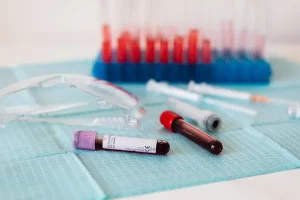5 Blood Tests You Should Have Once a Year

Over the age of 40 years, it is a good idea to have routine blood tests once a year
If you are Black or Asian, starting at age 30 years is recommended. This is because of their increased likelihood of diabetes, CKD and a high cholesterol (and prostate cancer in men). All three are ‘silent diseases’ (in their early stages).
All of these diseases have effective treatment .. especially if you start it early.
There are no NHS screening systems that carry these tests out. So, it’s up to you. But these are MyHSN’s recommendations.
1. Full blood count (FBC)
This test measures three components of your blood (red blood cells, white blood cells, and platelets). It can help identify issues like anemia, infection, or inflammation, and even some types of cancer.
- Haemoglobin (‘Hb’)
- 130-170 g/L for men
- 110-150 g/L for women
- The Hb reflects the number of red cells (which carry oxygen) in the blood – a higher number means more red cells. A low haemoglobin is called anaemia. A high haemoglobin is called polycythaemia
- White cell count (WC) = 4-11 x10^9/L (million per litre). These cells fight infection (and cancer and foreign bodies inside you)
- Platelet count = 150-400 x10^9/L (million per litre). These cells clot the blood.
2. Biochemistry
This assesses your liver and kidney health, as well as other essential minerals. It can detect conditions like diabetes, chronic kidney disease (CKD), or liver problems. In the USA, it is sometimes called a Comprehensive Metabolic Panel (CMP).
It usually comprises:
- U&Es
- Liver function tests (LFTs)
- Bone biochemistry
A phrase ‘U+E, LFTs and bone’ is sometimes used to describe this group of tests. We wll now go through them in more detail.
- U&E (urea and electrolytes)
- Sodium (Na) = 135-145 mmol/L.
- Potassium (K) = 3.5-5.3 mmol/L.
- Urea (U) = 3-7 mmol/L. High in CKD or AKI.
- Creatinine (Creat) = 60-120 μmol/L. High in CKD or AKI.
- Glomerular filtration rate (GFR) = 90-120 ml/min/1.73m². Low in CKD – how your CKD stage is calculated
- Liver function tests (LFTs) – also called liver enzymes
- Bilirubin (bili) = <21 µmol/L. High in liver disease
- Alkaline phosphatase (alk phos, ALP) = 30-130 IU/L. There are bone and liver types of alk phos
- ɣ–glutamyl transpedtidase (GGT) = 1-55 IU/L
- Alanine aminotransferase (ALT) = 15-45 IU/L
- Aspartate aminotransferase (AST) = 15-42 IU/L
- Albumin (Alb) = 35-50 g/L.Low in liver disease
- Globulin (Glob) = 20-40 g/L
- Total protein (TP) = 60-80 g/L.
- Bone biochemistry
- Calcium (Ca) = 2.2-2.6 mmol/L. It is the primary mineral in bones, and is crucial for bone health
- Phosphate (PO4) = 0.8-1.4 mmol/L. Also essential for bone structure and works in conjunction with calcium
- Alkaline phosphatase (alk phos, ALP) = 30-130 U/L – an enzyme that indicates bone formation activity, with elevated levels signifying increased bone turnover.
3. Glucose and HbA1c
- Blood glucose = 4-6 mmol/L – and less than 8 mmol/L, two hours after a meal
- Prediabetes is diagnosed if your random blood glucose = 7-11 mmol/L
- Diabetes is diagnosed if your random blood glucose > 11 mmol/L (or a fasting blood glucose > 7 mmol/L)
- Haemoglobin A1c (HbA1c) = 20-42 mmol/mol (or 4-6%)
- Prediabetes is diagnosed if your HbA1c = 42-47 mmol/mol (6-6.5%)
- Diabetes is diagnosed if your HbA1c > 47 mmol/mol or over (>6.5%).
4. Cholesterol (and lipids)
- Total cholesterol (chol) = 3-5 mmol/L – overall amount of cholesterol in your blood
- HDL (‘good’) cholesterol. Target level = >1 mmol/L – may make you less likely to have a heart attack or stroke
- Non-HDL/LDL (‘bad’) cholesterol. Target level = <4 mmol/L – may make you less likely to have a heart attack or stroke
- Triglyceride (TG). Target level = <1.7 mmol/L
- Cholesterol/HDL ratio = <4.
Men
5a. PSA (prostate specific antigen)
- Prostate specific antigen (PSA; men only) = <3 ng/ml. A high level of PSA can be a sign of prostate cancer. But your PSA level can also be raised in prostate conditions that are not cancer (see here).
Women
5b. Thyroid function tests (TFTs)
- TSH: 0.5 – 5.0 mU/L. This is the most important thyroid test. High TSH indicates an underactive thyroid – low indicates overactive
- Free thyroxine (T4): 8.0 – 18.0 pmol/L
- Free triiodothyronine (T): 3.8 – 6.0 pmol/L.

